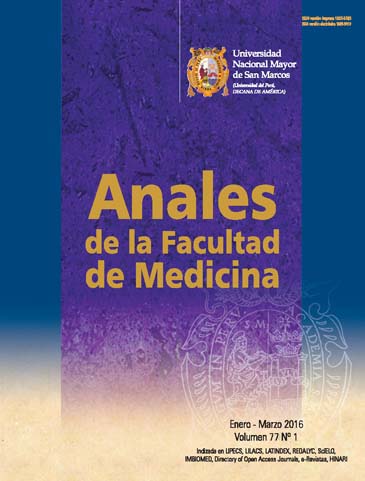Biophysical modifications during the El Niño phenomenon and correlation with encephalitis virus epidemic in Talara, Peru 1997-1998
DOI:
https://doi.org/10.15381/anales.v77i1.11615Abstract
El Niño occurs every 4 to 7 years; It is part of an atmospheric ocean natural event known as ENSO (El Niño-Southern Oscillation). Under normal conditions, on the west side of the Pacific Ocean there is a sea temperature of 29 ° C and a system of low atmospheric pressure in Darwin Australia; while on the east side there is a high pressure system in Papeete-Tahiti and level the coasts of Peru and Ecuador, where the sea temperature is 19 to 23 ° C. The cold waters of the eastern Pacific condition in the atmosphere high pressure zones and the warm waters of low pressure zones; the pressure difference causes the trade winds traveling from east to west, dragging surface waters and producing an upwelling phenomenon, whereby, the colder waters of the sea bottom out at the surface. The deep waters are rich in salts and micronutrients for the formation of phytoplankton base of the food chain in fish. Phytoplankton live in the illuminated upper layers; It is important in the processes of ocean-atmospheric interaction modulates heat production dimethyl sulfide (DMS); influence ocean chemistry using carbon dioxide dissolved in water to produce sugar and oxygen. It uses inorganic nutrients such as nitrogen, phosphorus, silicon, iron to synthesize complex molecules such as proteins.Downloads
Published
2016-03-14
Issue
Section
Cartas al Editor
License
Copyright (c) 2016 Mónica Briceño Aliaga

This work is licensed under a Creative Commons Attribution-NonCommercial-ShareAlike 4.0 International License.
Those authors who have publications with this magazine accept the following terms:
- Authors will retain their copyrights and guarantee the journal the right of first publication of their work, which will be simultaneously subject to Creative Commons Attribution License that allows third parties to share the work as long as its author and its first publication this magazine are indicated.
- Authors may adopt other non-exclusive licensing agreements for the distribution of the version of the published work (eg, deposit it in an institutional electronic file or publish it in a monographic volume) provided that the initial publication in this magazine is indicated.
- Authors are allowed and recommended to disseminate their work over the Internet (eg: in institutional telematic archives or on their website) before and during the submission process, which It can produce interesting exchanges and increase quotes from the published work. (See El efecto del acceso abierto ).
How to Cite
1.
Briceño Aliaga M. Biophysical modifications during the El Niño phenomenon and correlation with encephalitis virus epidemic in Talara, Peru 1997-1998. An Fac med [Internet]. 2016 Mar. 14 [cited 2025 Jun. 7];77(1):75-6. Available from: https://revistasinvestigacion.unmsm.edu.pe/index.php/anales/article/view/11615



